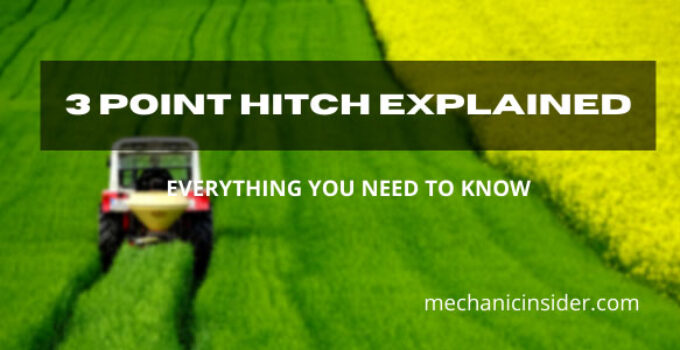Hitch is a type of connection used to connect equipment to the back end of large agricultural tractors. The hitch hooks towards the tractor at three points: lower right, lower left, and top center. But is this how a 3-point hitch explained?
A three-point hitch is a recognized mechanism of three moveable arms arranged in an ‘A’ shape. A hydraulic system operates the arm and helps with the movements. Among the types, Category 3 is fortractors of 110-220 horsepower, and the Category 4 hitch is for heavy-duty tractors with engines that produce more than 180 horsepower.
It is one of the most advanced features of agricultural technology. A form of 3-point hitch system is now found on practically every tractor.
Purpose Of 3 Point Hitch
The primary function of a three-point hitch is to carry the load and resistance of equipment to the tractor’s drive wheels. It gives the tractor the same strength, load, and fuel usage as usual, which provides more helpful traction.
The three-point tractor hitch has changed several areas of farming. Following the introduction of the tractor, this modest and inventive device served to usher in a new period in agricultural life.
It boosted the efficiency of a farmer’s tractor and allowed for a larger yield. It also eliminated physical effort to carry or lift heavy loads.
3 Point Hitch Components
A 3-point hitch (sometimes known as a three-point linkage in a tractor) is a well-known mechanism for connecting implements to tractors. They are made up of three moveable arms arranged in an ‘A’ shape. The arms seen in a 3-point hitch diagram are operated by a hydraulic system that allows raising, lowering, and tilting.
It is composed of several components that function together. These components are the lifting arms, attaching points, stabilizers, leveling box, and the tractor’s hydraulic system.
3 Point Hitch Categories
The three-point hitch is categorized into the following categories based on their general significance:
Category 0
Upper and lower link pins with a diameter of 5/8 inch fall into the smallest group. There is about a 20-inch gap between the two lifting arms.
Category 0 hitches are found on light-duty gardening tractors with less than 20 horsepower.
Category 1
The 3-point hitch top link pin has a diameter of 3/4 inch, whereas the two lift arm pins have a diameter of 7/8 inch. These lifting arms are spaced roughly 26 inches apart. It’s designed for tiny tractors (less than 50 horsepower).
There are also limited “Category 1” hitches. These hitches seem to be the same size as standard Category 1 hitches. And they may be unable to raise all Category 1 objects as high as required for proper performance.
Category 2
Category 2 hitches are equally prevalent on tractors ranging in horsepower from 40 to 125.
A Category 2 hitch raises the diameter of the top link pin to 1 inch and the lift arm pins to 1 1/8 inch depending on horsepower. The distance between the arms extends to around 32 inches.
Category 3
The Category 3 hitch raises the sizes of the link pins to 1 1/4 inch (top link pin) and 1 7/16 inch (bottom link pin) (lift arm pins). It provides extra strength required for heavily loaded implements driven by tractors ranging from 80 to 225 horsepower.
The lifting arms’ distance from one another can be varied. The width of a straight Category 3 hitch is about 38 inches, whereas the minor Category 3N hitch is around 32 inches wide.
Category 4
The most reliable three-point hitch category increases the link pin sizes by 1/2 inch or more. They measure 1 3/4 inch (top link pin) and 2 inches (bottom link pin) (lift arm pins).
It isn’t easy to imagine a work that a Category 4 hitch can’t face. The device is designed for heavy-duty tractors with engines that produce more than 180 horsepower. You get one of these when you need to handle larger loads regularly.
How Does 3 Point Hitch Work?
The 3-point hitch geometry is shaped like a triangle. It includes two movable arms and a top-mounted adjustable center link. Although the top link can be adjusted, it’s not usually controlled by the tractor’s hydraulic system.
The lower two arms are the hitch’s lifting arms, and they operate through the hydraulic system. These arms allow the tractor hitch to be raised and lowered.
At the top of the right arm is a manual screw for adjusting the implement. The lower arms have hydraulic cylinders that lift and drop the tool.
An extra hydraulic arm may function to manage the draft (deep) of tillage equipment. The driver controls the tractor’s hydraulic system. A range of settings is frequently provided.
How To Install A 3 Point Hitch?
If you’ve recently bought a tractor, one of the most frightening things to learn is how to connect a three-point hitch. Typically, it becomes easier as you practice. You can also follow a 3-point hitch dimensions diagram for easier understanding.
Equipment Needed
Here are some things you should have on hand to install a three-point hitch on your tractor:
- a farm implement
- two hitch rods
- an adjustable drawbar
- four locking hitch pins
7 Easy Steps to Install A 3 Point Hitch
Installing a 3-point hitch is relatively straightforward. Here are some easy steps to follow:
Step 01: Align the tractor perfectly with the implement mounting before installing. That’s because the hitch will force you to adjust the application from side to side.
Step 02: Back up to the farming implement with the tractor. Put the tractor in balance.
Step 03: Reduce the hydraulic lift arms until they are aligned with the implement’s bottom attachment points.
Step 04: Put the implement’s bottom attachment pin on the tractor’s lift arms into that little spinning ball. Use a lockable hitch pin on every attachment pin to fasten the instrument to the tractor.
Step 05: Connect one side of the adjustable drawbar to the upper connection point of the implement using a hitch rod. Then, get a lockable hitch pin to attach the drawbar.
Step 06: Connect the other end of the drawbar to the tractor’s upper hitch point using a hitch rod. Use a lockable hitch pin to attach the drawbar. You might need to extend or shorten it to fit the instrument and the tractor.
Step 07: Raise the implement off the ground with the tractor’s hydraulic lift. Then, adjust the drawbar to straighten the implementation when needed.
You can use a fixed 3-point hitch drawbar if an adjustable drawbar is unavailable. But it’s more challenging to operate.
Final Words
Tractors are handy tools for completing a wide range of activities on a farm. Nowadays, 3-point hitches are standard equipment on the majority of tractors. The three-point hitch has been categorized into different tractor types. It allows implements of one size to be used with any tractor that can support the size. So, you should be familiar with the three-point hitch. You’ll be well equipped as well on 3 point sprayer also if you get the basics right.
Hopefully, this 3-point hitch explained has provided sufficient information on a tractor’s three-point hitch. So, figure out which one is required for your farm. Best wishes for your farming venture!



